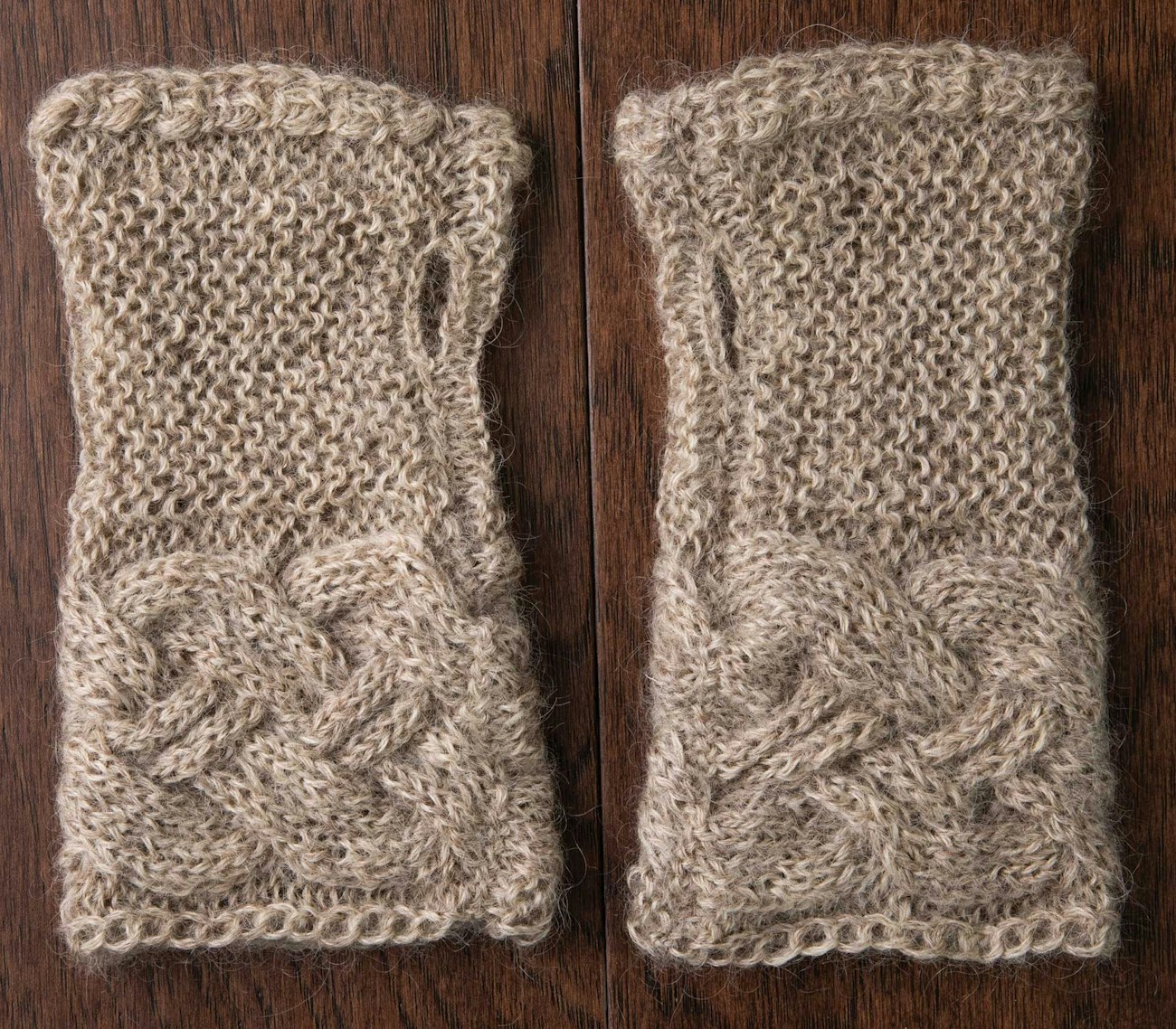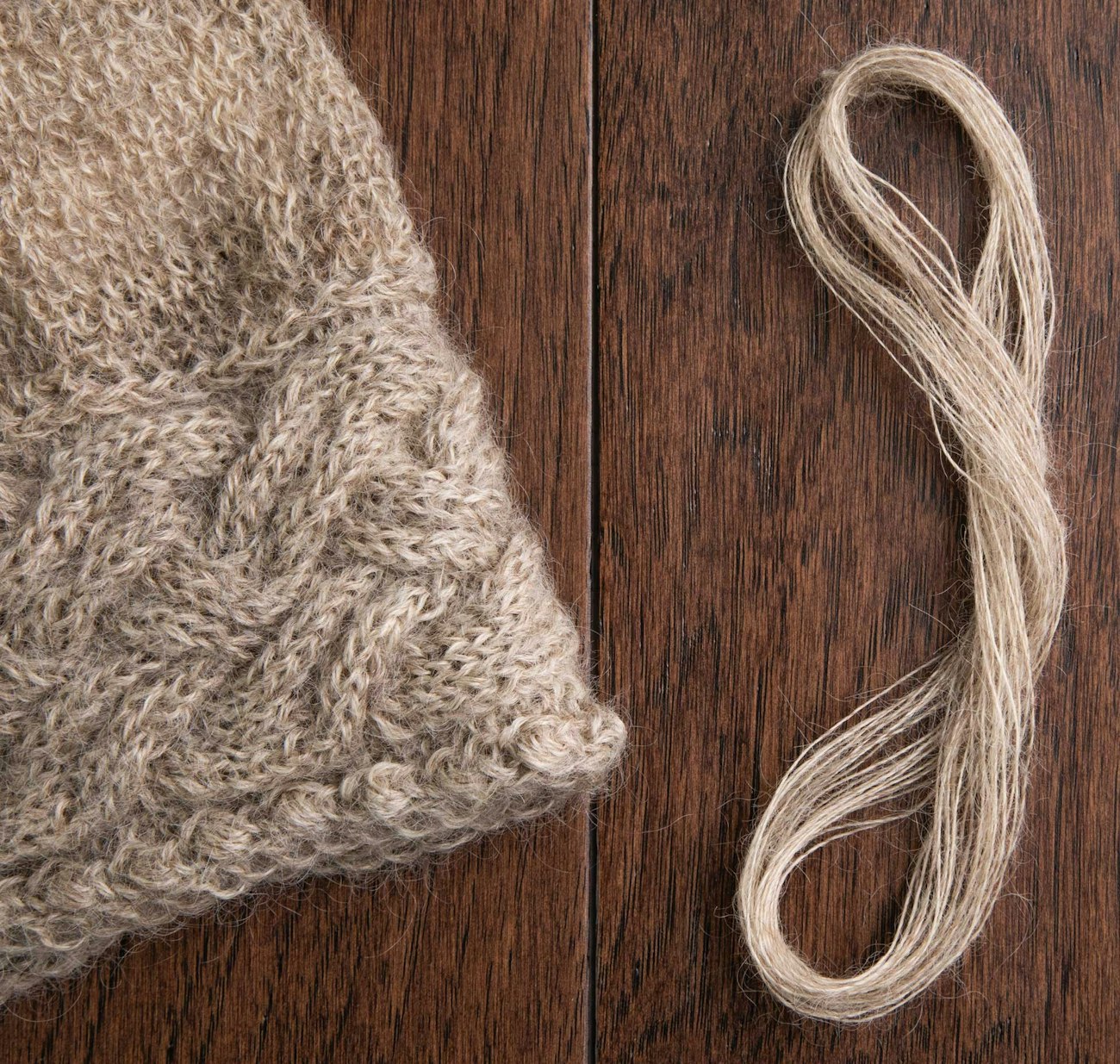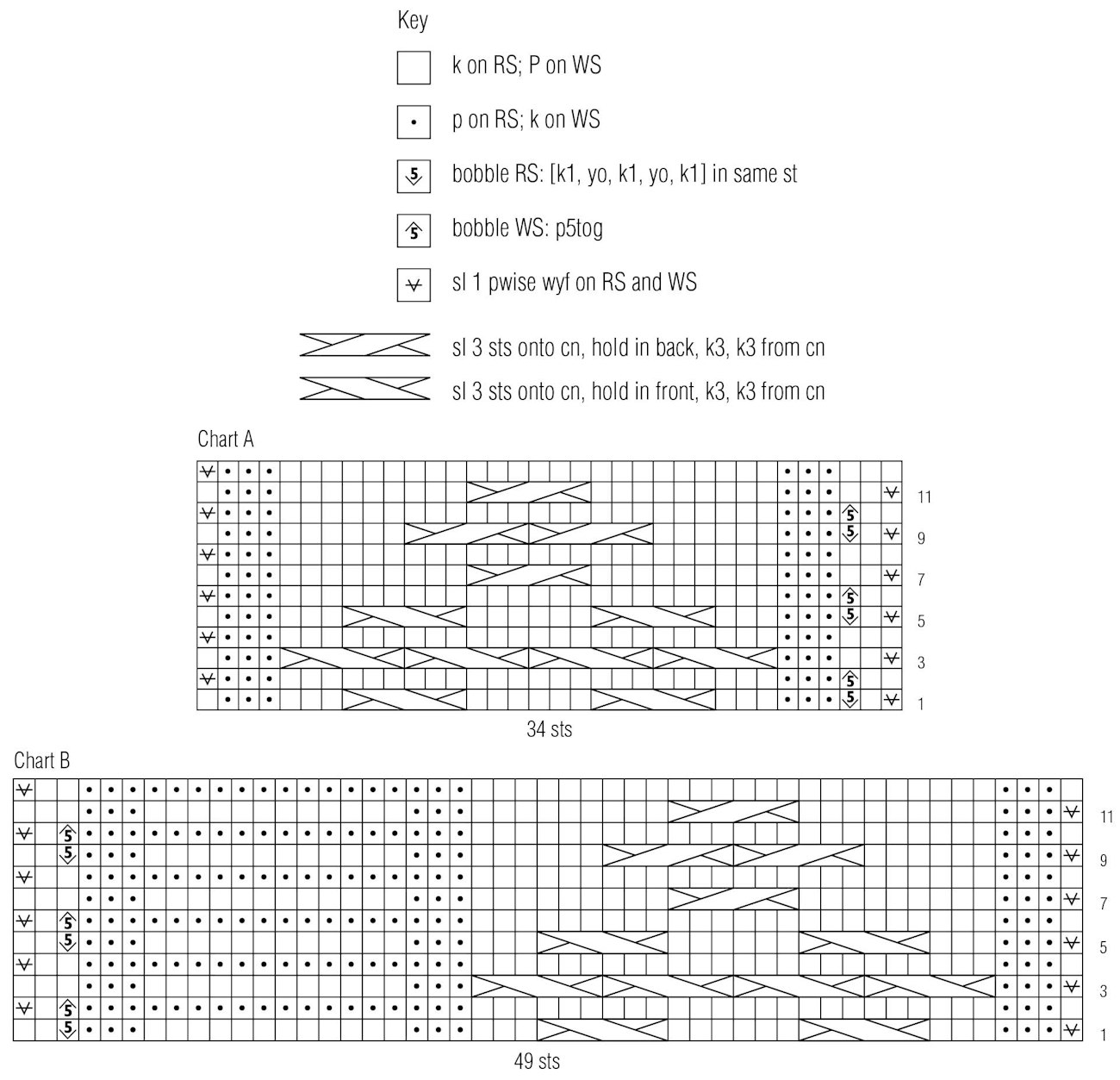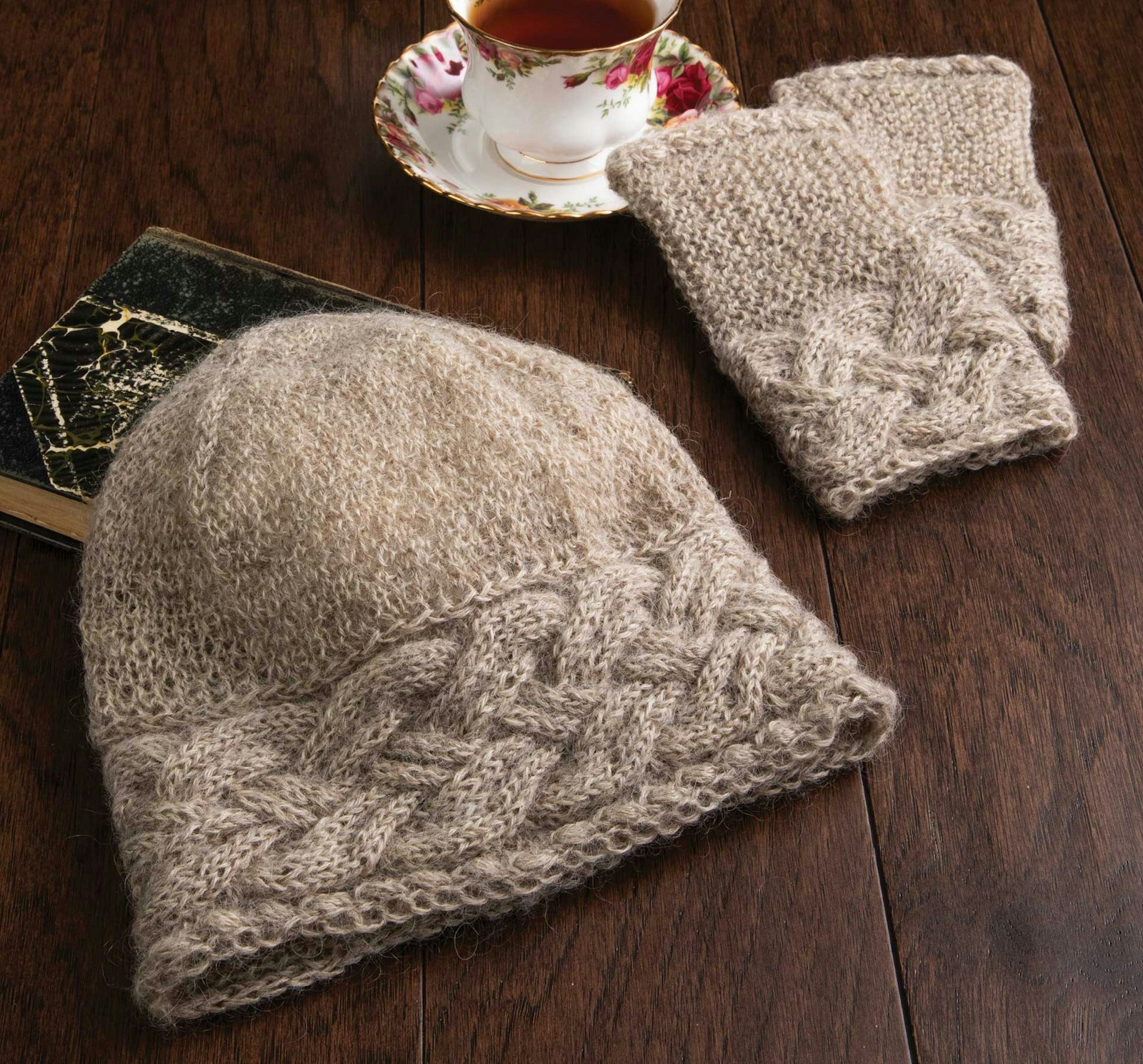https://pieceworkmagazine.com/cdn-cgi/image/format=auto/https://www.datocms-assets.com/75076/1656661621-leicester-hat-and-mitts-1.jpg?auto=format&w=900
I created this hat and mitt set using yarn produced by Wool Out of Wales, a company specializing in wool from Leicester Longwool sheep. According to the company, the unique climate of Wales allows a long grass-growing season, which in turn contributes to a lustrous and long-staple fleece.
Leicester Longwool yarn pairs well with knitted textures created using cable, bobbles, and rogozka patterns. Pronounced “ro-go-zh-ka,” this Russian word refers to a thick fabric with a textured, checkered surface.
[PAYWALL]

Thumbholes are created when seaming each mitt.
Historic Leicester Longwools
Leicester Longwools, also known as English Leicesters, are one of three Leicester sheep breeds that exist today. Leicester Longwools, along with cousins Border and Bluefaced Leicesters, trace their roots back to a flock that grazed on a farm called Dishley Grange in Leicestershire, England, during the late eighteenth century.
Leicester sheep at that time were described as longwools that tended to be lanky and large-framed. A young farmer named Robert Bakewell (1725–1795), returning to his family home at Dishley Grange, noticed that some of the smaller, more compact sheep could be just as productive as their larger counterparts in less time. Thus, he set out to improve his flock, eventually creating a new breed called the Dishley Leicester or New Leicester.
Robert Bakewell would become one of the most noteworthy figures in the history of animal husbandry and made his contributions to the field of genetics before either Charles Darwin or Gregor Mendel was born.
The Dishley Leicesters caused quite a stir in the late eighteenth century. These fashionable sheep could be found throughout Britain among the flocks of progressive farmers and occupied the thoughts and letters of modern agriculturalists. George Washington and Thomas Jefferson, both renowned shepherds, indicated in their letters that they followed Bakewell’s work and the impact his sheep were having on flocks in Britain, Europe, and North America.
Leicester Longwools, the closest descendants to Bakewell’s sheep that remain today, are a conservation breed in both the United Kingdom and United States.
To learn more, visit the Livestock Conservancy, www.livestockconservancy.org.
Leicester Longwool yarns are available at The Ross Farm, www.therossfarm.com.
—Editor

Leicester Longwool singles yarn from Wool Out of Wales.
Materials
- Wool Out of Wales (Lana dal Gailes) Black Leicester Longwool, 100% wool yarn, fingering weight, 546 yard (500 m)/3.53 oz (100 gram) skein, 1 skein Natural Grigio (See “Historic Leicester Longwools” above for additional yarn resource.)
- Needles, Addi Lace size 2 (3 mm) circ 16 inches (40 cm), and set of Addi FlexiFlips 4 or 5 double pointed size 2 (3 mm) or size needed to obtain gauge
- Cable needle
- Stitch markers, 4 different colors or styles
- Smooth, contrasting waste yarn
- Tapestry needle
Finished size:
Hat: 18 inches (45.7 cm) head circumference (will stretch to fit up to 20 inches [50.1 cm]) and 9¼ inches (23.5 cm) tall
Mitts: 7 inches (17.8 cm) hand circumference and 7½ inches (19.1 cm) long
Gauge: 20 stitches and 36 rows = 4 inches (10.2 cm) in garter stitch using a double strand of yarn; 32 sts and 44 rounds = 4 inches (10.2 cm) in Rogozka patt using a single strand of yarn
Special Stitches and Techniques
Bobble
The bobble for this project is worked over 2 rows as shown on the charts. On RS rows, work [k1, yo, k1, yo, k1] loosely all in same st—1 st inc’d to 5 sts. On the following WS row, purl the 5 bobble sts together—5 sts dec’d back to 1 st.
Rogozka (even number of sts)
Rnd 1: * K1, sl 1 knitwise with yarn in front (kwise wyf); rep from *.
Rnd 2: K all sts.
Rnd 3: * Sl 1 kwise wyf, k1; rep from *.
Rnd 4: K all sts.
Rep Rnds 1–4 for patt.
Russian Grafting Method
Set-up: Sl 1 st from right needle to left needle.
Step 1: Insert right needle tip into first st on left needle and draw second st on left needle through the first st and onto the tip of the right needle. Drop the first st from the left needle.
Step 2: Insert left needle tip into first st on right needle and draw second st on right needle through the first st and onto the tip of the left needle. Drop the first st from the right needle.
Rep Steps 1 and 2 until 1 st remains.

Instructions
Notes: Visit www.pieceworkmagazine.com/abbreviations for Abbreviations.
Begin the hat by working a headband brim with cables and bobbles. After joining the ends of the headband, stitches for the crown are picked up along one edge and worked upwards in the round in the Rogozka pattern. Each mitt is worked flat in one piece from side to side. The mitts are identical and can be worn on either hand.
Hat
Headband Brim
With circ needle and waste yarn, CO 35 sts. K 4 rows, decreasing 1 st in first row—34 sts. Change to using 2 strands of main yarn held together. K 2 rows. Work Rows 1–12 of Chart A 11 times—132 chart rows completed. Carefully remove waste yarn and place 34 exposed loops from base of CO sts on an empty double-pointed needle. Taking care not to twist the brim and starting at the bobbled edge, use the Russian grafting method (see Special Stitches and Techniques) to join the live sts together—1 st rem.
Crown
Hold the brim with RS facing and edge without bobbles along the top. Using double-pointed needles, pick up 68 sts evenly around (about 1 st for every 2 chart rnds) and pick up 1 rem st from brim—69 sts total. Continue as follows using a single strand of yarn:
Next rnd: * K1, yo; rep from * to end—138 sts.
Next rnd: Place marker (pm) for beg of rnd, k23, [pm, k46] 2 times, pm, k23.
Work Rogozka patt (see Special Stitches and Techniques) with separating sts as follows:
Rnd 1: Sl m, work 22 sts in Rogozka patt, k1, [sl m, k1, work 44 sts in patt, k1] 2 times, sl m, k1, work 22 sts in patt.
Rnd 2: Sl m, work 22 sts in Rogozka patt, sl 1 purlwise with yarn in back (pwise wyb), [sl m, sl 1 pwise wyb, work 44 sts in patt, sl 1 pwise wyb] 2 times, sl m, sl 1 pwise wyb, work 22 sts in patt.
Continuing Rogoska sts in established patt, work the separating sts according to the last 2 rnds until the piece measures 2 inches (5.1 cm) from pickup rnd, ending with Rnd 2.
Decrease rnd: Sl m, work in patt to 2 sts before m, k2tog, [sl m, ssk, work in patt to 2 sts before m, k2tog] 2 times, sl m, ssk, work in patt to end—6 sts dec’d.
Next rnd: Sl m, work in patt to 1 st before m, sl 1 pwise wyb, [sl m, sl 1 pwise wyb, work in patt to 1 st before m, sl 1 pwise wyb] 2 times, sl m, sl 1 pwise wyb, work in patt to end.
Rep the last 2 rnds 20 more times, changing to double-pointed needles when necessary—12 sts rem.
Next rnd: Sl m, k2tog, [sl m, ssk, k2tog] 2 times, sl m, ssk—6 sts rem.
Cut yarn, leaving an 8-inch (20.3 cm) tail. Thread tail through rem sts, pull snugly to close hole at top of hat, then fasten off tail on WS.
Finishing
Weave in ends. Steam or handwash and let dry.
Mitts
With circ needle and waste yarn, CO 50 sts. K 4 rows, decreasing 1 st in first row—49 sts.
Change to using 2 strands of main yarn held together. K 2 rows. Work Rows 1–12 of Chart B 5 times—60 chart rows completed.
Carefully remove waste yarn and place 49 exposed loops from base of CO sts on an empty needle. Taking care not to twist and starting at the cable pattern edge, use the Russian grafting method (see Special Stitches and Techniques) to join 38 live sts together—11 sts rem on each needle. For the thumb opening, BO the next 6 sts on left needle without joining them, then BO the next 6 sts on right needle without joining them. Resume working in Russian grafting and join the rem live sts together—1 st rem. Cut an 8-inch (20.3 cm) length of yarn, thread yarn through rem st to secure it, and fasten off.
Finishing
Weave in ends. Steam or handwash and let dry.
Inna Voltchkova was born in Kiev, Ukraine, is a graduate of the Kiev National University of Technology and Design, and later moved to the Chicago area. For the past 25 years, Inna’s passion has been lace knitting, especially Russian-style lace. Winner of the 2010 TKGA Design Contest, Inna’s beautiful lace designs have frequently appeared in PieceWork since 2009.
This project was published in the Spring 2020 issue of PieceWork.




